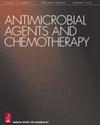大环内酯类过敏患者的非达霉素过敏发生率:一个大型数据库分析。
IF 4.1
2区 医学
Q2 MICROBIOLOGY
Antimicrobial Agents and Chemotherapy
Pub Date : 2025-04-02
Epub Date: 2025-03-04
DOI:10.1128/aac.01924-24
引用次数: 0
摘要
非达霉素对已知大环内酯类过敏的患者可能表现出交叉反应性。在本分析中,与无大环内酯类过敏的患者相比,阿奇霉素、克拉霉素和红霉素过敏的患者发生非达霉素过敏的几率分别高出2.31倍、8.37倍和1.58倍;阿奇霉素、克拉霉素和红霉素过敏患者发生非达霉素过敏的绝对风险分别为0.033、0.01和0.039。过敏反应和血管性水肿的最高风险出现在非非达霉素大环内酯过敏的1年内。本文章由计算机程序翻译,如有差异,请以英文原文为准。
Incidence of fidaxomicin allergy in patients with macrolide allergies: a large database analysis.
Fidaxomicin may exhibit cross-reactivity in patients with known macrolide allergies. In this analysis, compared to patients without macrolide allergies, the odds of fidaxomicin allergy were 2.31, 8.37, and 1.58 times higher in patients with azithromycin, clarithromycin, and erythromycin allergies, respectively; the absolute risk of fidaxomicin allergy was 0.033, 0.01, and 0.039 in patients with azithromycin, clarithromycin, and erythromycin allergies, respectively. The highest risk of anaphylaxis and angioedema was observed within 1 year of a non-fidaxomicin macrolide allergy.
求助全文
通过发布文献求助,成功后即可免费获取论文全文。
去求助
来源期刊
CiteScore
10.00
自引率
8.20%
发文量
762
审稿时长
3 months
期刊介绍:
Antimicrobial Agents and Chemotherapy (AAC) features interdisciplinary studies that build our understanding of the underlying mechanisms and therapeutic applications of antimicrobial and antiparasitic agents and chemotherapy.

 求助内容:
求助内容: 应助结果提醒方式:
应助结果提醒方式:


